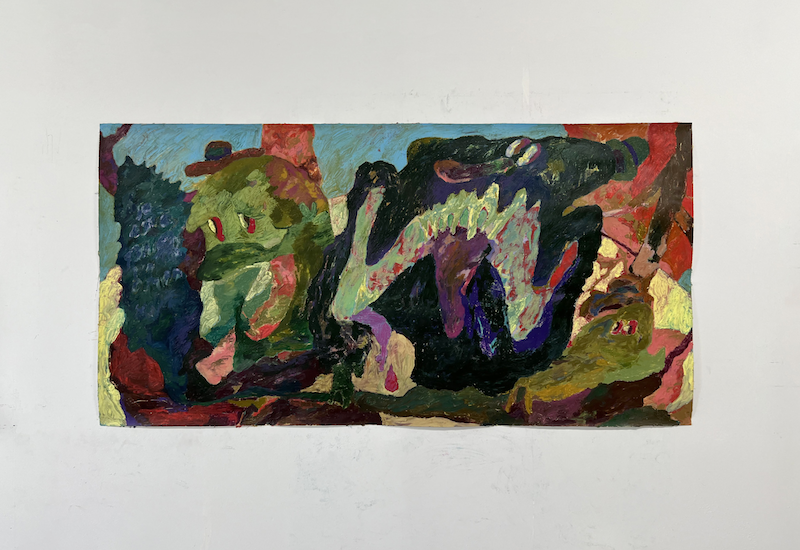
By Manon Pouliot, Head of the Loto-Québec Collection, and Sarah Kitzy Gineau Delyon, Director of artch

By Manon Pouliot, Head of the Loto-Québec Collection, and Sarah Kitzy Gineau Delyon, Director of artch
Sarah, December 15, 2024
Let’s assume that the human imagination has no known end, that it can never be exhausted, but rather multiplies infinitely, creating unique imaginary worlds. Each creator can, in this sense, establish their own rules and construct their own laws within a conceived space. Since the limits of time and space do not exist in the vortex imaginarium, artists can embrace the irrational and the impossible without physical or logical constraints.
Let us define imagination as a pure space of freedom, where the inconceivable and the fantastic coexist without barriers, beyond the laws of what has already been seen. This free space does not have to represent the world as it is perceived. Each individual is free to push the impulse of creation to infinity, just as our surrealist artist friends have done, blurring the boundaries between reality and myth.
One may then wonder if the artist creates an imaginary world structured by laws, cycles, series, and patterns, or if this world surpasses human thought itself. How can this imaginary realm exist beyond the mind that conceived it? Could it stretch infinitely, especially through an artwork destined to be viewed by different individuals, each capable of shaping their own imaginary interpretations? The resonance of artworks extends this initial imaginary world into a shared one, reinterpreted and absorbed by those who experience it.




Manon, December 20, 2024
We understand that artists draw inspiration from their environment: they are moved by their concerns about the current state of the world, by suffering, by beauty, by their origins. They borrow symbols, codes, and iconographies from various eras and from their daily experiences. Combined with their imagination, their creations become part of an endless, metaphorical universe, a refuge uniquely their own, where they feel free from all constraints.
This universe is composed of contrasts that both oppose and attract one another, forming an immense array of tangible and intangible possibilities, blending materiality and immateriality, which underpin the very foundation of their artistic approach:
The artist creates based on what they wish to convey to the spectator and/or viewing public. Their imaginary world is built from personal experiences (human evolution, history, science, motherhood, fear of the other, technological advancements, the construction of dreams, etc.), which they share with others. These experiences place both the artist and the audience at the heart of this imaginary world and the creative process itself. The entirety of these feelings, material and immaterial, visible and invisible, forms an unending succession of images, where time and space dissolve into infinity.
Discover Et si les moulins tournaient sans jamais s’arrêter, an emerging art exhibition collaboratively curated by Loto-Québec and Artch, at booth P05 on the 2nd floor of the fair's pavilion, from April 11 to 13.


The artists:
Kelly Davis explores the mystical realm of the imaginable, where abundance and infinite expansion reign. Through her abstract paintings, she creates portals to an invisible yet deeply felt reality, offering a space for personal and collective resonance. Her work is part of an ongoing dialogue, activated by the viewer’s engagement and nourished by an intuitive exchange that transcends language.
Gabor Bata draws and paints characters from his imagination who constantly try, but inevitably fail, to communicate and connect. He creates vibrant, voluptuous scenes that captivate the eye, influenced by his love of cinema, animation, comics, and design.
Alfred Muszynski sees his work as research, “a network of ideas above all.” His pieces intertwine codes and iconographies from the past and present, playing with reality and myth like a puzzle. His work is a network of symbolic references, where each painting finds its place within the system he has constructed.
Alex Pouliot seeks to reclaim the magic of art by exploring the invisible forces that shape appearances and individual identity. Often in dialogue with specific locations, his work questions the influence of Western cultural supremacy in mass media and its role in constructing and colonizing collective imaginaries.
Judith Berry (Loto-Québec Collection): “This small painting is one of my many attempts to condense the landscape into a surface that feels manipulable. The winding spiral paths evoke an imposing form, similar to a hill. Yet, the painted surface remains opaque, with each gesture inscribed directly onto it. The image suggests vast expanses while taking on the appearance of a tangible object or a body fragment. This piece is part of a decades-long exploration aimed at blending the genres of landscape, still life, and portraiture. I confront the notion of landscape, our relationship to the environment, and the ways in which its transformations affect us.”
Mélanie Dumas explores materiality by engaging with space, fullness, and emptiness to reveal new geometries. Her work examines the concept of landscape through forms inspired by the living and synthetic structures that compose it. Balancing fragility and robustness, stillness and movement, she selects raw materials to highlight their properties and temporality. By incorporating active systems, she creates sculptures that reproduce natural phenomena on a small scale, questioning our relationship with the Anthropocene.